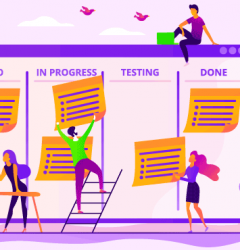
Tim owns a company that develops websites. After winning a major upcoming contract, he must determine if adding a team member would benefit him. Most of his time is spent double-checking mistakes and missing details in his project management system. If he assigned these tasks to a new team member, he and his designers would be able to take on more significant contracts.
There is a simple website design project under contract at the moment. Tim could save time, decrease frustration, and cross-train his employees if he could organize his business processes so everyone had an organized set of instructions.
Tim is losing time and money because he does not have formal documentation for his business processes. How much does it cost you?
What is a Business Process?
A Business Process is a set of related, structured activities and steps performed by individuals or equipment within an organization to achieve the organization’s basic objectives like profit maximization and customer satisfaction.
Business processes can be repeated at all organizational levels and may or may not be visible to customers.
Several related ideas about Business Process Management (BPM), Process Optimization, Process Mapping, Process Simulation, and Process Automation are often viewed as flow charts or workflows of logical steps.
A business process is similar to a race, intending to get from the starting line (the beginning) to the end. Depending on what’s vital for success in a particular business, different parts of the process may need more attention than others.
Let us take an example from the employee offboarding process to get a better understanding:
- Recognizing resignations/terminations
- Negotiating the retention of the employee
- Procedures for notice and final settlement
- Project planning and task assignment
- Handover and knowledge transfer of project details and company information
- Legal and Compliance Requirements
- Notification to Team and Clients
- Security and Data Protection
- Interviews at exit
An employee offboarding process typically involves these activities. By acknowledging and negotiating with the employee, the business attempts to retain him or her. Following the resignation, the employee and company can clarify the terms of their contract through the notice period and final settlement procedures. As a result of the project planning and handover activities, the business can prevent employee resignation from affecting daily processes. Additionally, the exit interview gives the company a chance to improve its policies and operations through detailed feedback.
The projected expansion of the BPM market anticipates a 10.5% rise, hitting a valuation of $14.4 billion by 2025.
Your operations depend on business processes, so improving them is strategically important.
Why are business processes important?
Business processes are vital for several reasons. They streamline operations, maintain consistency, enable scalability, ensure compliance, simplify training, enhance problem-solving, and boost customer satisfaction. Additionally, they foster innovation, support data-driven decision-making, and enhance competitiveness in a dynamic business environment.
Business Process vs. Business Procedure vs. Business Function
These three terms—business process, business procedure, and business function—are often used interchangeably, but they have distinct meanings in a business context:
1. Business Process
A business process is a high-level sequence of activities or tasks that achieve a specific business goal. It typically involves multiple departments and resources.
🔹 Example: Order fulfillment (from receiving an order to delivering the product).
🔹 Key Features:
- End-to-end workflow
- Cross-functional (involving different teams)
- Aimed at achieving a business objective
2. Business Procedure
A business procedure is a detailed, step-by-step method for performing a specific task within a business process. It provides instructions on how to complete a particular part of a business process.
🔹 Example: The steps a customer service rep follows to handle a return request within the order fulfillment process.
🔹 Key Features:
- Specific set of instructions
- Defines “how” a task should be performed
- Usually follows standard operating procedures (SOPs)
3. Business Function
A business function refers to a broader category of activities that a company performs to achieve its goals. Functions are groupings of related tasks that may include multiple business processes.
🔹 Example: The finance function includes processes like budgeting, accounting, and payroll.
🔹 Key Features:
- High-level business activity
- Can include multiple processes
- Usually tied to a department (HR, marketing, finance, etc.)
Also Read : What is Business Process Optimization? Proven Techniques & Insights
Business Process Categories and Examples
Business processes can be broadly categorized into three main types, each serving a specific purpose within an organization.
1. Core (Primary) Processes
Definition: These are mission-critical processes that directly deliver value to customers and contribute to revenue generation.
🔹 Examples:
- Order-to-Cash (O2C): Managing customer orders from placement to payment.
- Procure-to-Pay (P2P): Handling procurement, from supplier selection to payment.
- Product Development: Creating and launching new products/services.
- Customer Onboarding: Setting up new customers for products/services.
🛠 Example Industry Use Case:
- E-commerce: The checkout and payment process ensures customers receive their orders.
2. Support (Secondary) Processes
Definition: These processes don’t directly generate revenue but are essential for enabling core processes to function smoothly.
🔹 Examples:
- Human Resource Management: Hiring, onboarding, payroll, and performance tracking.
- IT Support & Maintenance: Managing internal software, cybersecurity, and infrastructure.
- Procurement & Vendor Management: Ensuring supplies, contracts, and materials are available.
- Accounting & Financial Reporting: Managing company finances, invoicing, and compliance.
🛠 Example Industry Use Case:
- Manufacturing: The IT department ensures the ERP system runs smoothly for production planning.
3. Management (Strategic) Processes
Definition: These processes focus on business direction, governance, and continuous improvement to align with company goals.
🔹 Examples:
- Strategic Planning: Setting company vision, goals, and growth strategies.
- Performance Management: Monitoring KPIs and optimizing workflows.
- Risk Management & Compliance: Ensuring adherence to regulations and mitigating risks.
- Budgeting & Forecasting: Planning future financial investments and resources.
🛠 Example Industry Use Case:
- Banking: A compliance team ensures the bank follows regulatory guidelines and avoids legal risks.
Also Read: Step Into Success With These 7 Business Process Management Examples
Reasons to Have Well-defined Business Processes
Well-defined business processes are the backbone of any successful organization, offering a multitude of advantages. Firstly, they boost efficiency by eliminating confusion and inefficiencies, completing tasks faster and with fewer errors. Secondly, these processes ensure unwavering consistency, guaranteeing that every task is executed uniformly, thereby upholding the quality of products or services. Thirdly, they foster scalability, facilitating business growth without compromising on quality. Fourthly, clear processes ensure compliance with regulatory and industry standards, preventing costly violations.
Also, they expedite training, minimize the learning curve for new employees, and make problem identification more straightforward.
Moreover, they enhance customer satisfaction, as efficient processes lead to quicker responses and improved service quality. Furthermore, established processes create a solid foundation for experimenting with business process improvements and innovations. They also generate valuable data for analysis, enabling data-driven decision-making.
Streamlined processes provide a competitive advantage by enabling cost-effective and timely product or service delivery, positioning businesses ahead of the competition in today’s dynamic business environment.

Types of Business Processes: Navigating Terrain
In the bustling business landscape, processes are the roads leading to success. These processes, like diverse paths through a forest, take on various forms depending on the destination. Let’s explore the different types of business processes that weave the tapestry of operations:
1. Operational Processes
From inventory management to order processing & customer support, they ensure the core functions are executed efficiently.
2. Management Processes
It involves planning, organizing, and controlling resources to achieve strategic goals.
3. Supporting Processes
Supporting processes provide the infrastructure and resources required for the organization to function smoothly.
4. Development Processes
Innovation is the heartbeat of progress. Development processes focus on creating and improving products, services, and systems.
5. Sales and Marketing Processes
Sales processes involve lead generation, negotiation, and closing deals, while marketing processes encompass brand positioning, advertising & customer engagement.
6. Customer Relationship Management (CRM) Processes
Customers are the lifeblood of any business. CRM processes are designed to nurture and maintain relationships with customers.
7. Supply Chain Processes
Supply chain processes include procurement, manufacturing, logistics & distribution, ensuring products reach the right place at the right time.
8. Financial Processes
Budgeting, accounting, financial analysis & reporting processes guide organizations in managing resources, predicting trends & making informed choices.
9. Compliance and Regulatory Processes
Compliance processes ensure adherence to legal, industry, and internal standards, minimizing risks and maintaining ethical conduct.
10. Quality Assurance Processes
Quality assurance processes ensure products and services meet or exceed predefined standards, guaranteeing customer satisfaction and loyalty.
Each type of business process plays a distinct role, contributing to the harmonious functioning of an organization. Just as a diverse ecosystem sustains a thriving forest, a mix of these processes forms the foundation for a prosperous business. The above list isn’t complete, because businesses processes are anything process that takes place in a business.
Also Read: Business Process Mapping: Definition, Steps and Tips
7 Example of Business Processes
Businesses practice different processes according to their type, industry, location, etc., but a few are practiced across all segments of businesses worldwide. Using business process automation examples, we will make this easier to understand.

1. Onboarding process for clients
Professionalism, courtesy, and expertise are essential when onboarding new clients. When you acquire a big client, the last thing you want is your team sitting there wondering, “Okay, so what next?
Onboarding will be a thing of the past if you have a clear, defined process. As an example, let’s take a marketing agency.
- Set up an initial meeting. Become familiar with the client’s business, the industry, the competition, etc.
- Assess the goals and assets of the company. Make sure you know what your clients want from you, and how you can utilize their strengths to accomplish those goals
- Establish KPIs. To ensure that you’re bringing in results, the client will want to measure your progress
- Make an action plan. Your team’s plan for the week, month, year, etc.
Client pitch. Assess whether the proposed strategy is acceptable to them. Start over if necessary. All the tasks should be assigned to the appropriate team members.
2. The Sales process
The process of making a sale is fundamental across all industries, offerings, and segments. In most businesses, the following steps are followed:
- Proposal sharing
- Quotation sending
- The negotiation process
- Ordering products/services
- Maintaining sales records
- Product or service delivery
- Post-Sale Follow-up
- The billing process
- The payment process
- Renewals and Retention
There are repetitive steps in this process, and the workflow and structure can be modified to meet the business’s needs. Does your sales team not perform to its full potential?
Also Read: Top Business Process Management Stats to help you add efficiency
3. Process of procurement
To purchase the materials you need for your business, you follow these steps:
- Identifying a product’s need.
- Contact the purchasing department with a purchase requisition.
- The purchasing department reviews procurement requests.
- A budget approval request with all financial details is sent to the financial department.
- When a quotation request is approved, the purchasing department sends it out to suppliers, and they submit their bids.
- The vendor is then selected and a contract is signed.
- Upon receiving the goods, the purchasers inspect the quality of delivery.
- Orders and invoice slips must match for invoice payment to be approved.

4. Providing customer service
In global business operations, customer service is also an important process. The process involves the following steps:
- Using CRM, receive customer complaints and issues.
- Recognize the customer’s concern.
- CRM login information for the issue.
- Solve the problem.
- Inform the customer of the status.
- Process of recruitment.
- Process of invoicing.
- Processing of orders.
- The onboarding process for new customers.
- Keep track of your accounts.
- Process of conducting market research.
- Development of a product.
Read eBook: 11 Steps to Fix a Broken Process
5. Process of content marketing
Unless you organize your content marketing into clear business processes, it can be a very hectic mess. If you don’t work on this, you’ll end up with 20 articles still in the works, confused designers, and confused followers, waiting desperately for their weekly articles.
You can establish content marketing workflows in a variety of ways depending on your strategy.
Let’s take a look at a very basic publishing process as an example…
- A content writer begins drafting an article and finishes it. Please include a description of any custom images you intend to use.
- The marketer gathers influencer contact information for advertising and marketing as soon as the article is completed.
- A proofreader points out errors in grammar, style, spelling, etc.
- The designer creates custom images and sends them to the content writer.
- Comments are considered, mistakes are corrected, and images are added.
- In addition to ensuring that the article meets best practices for SEO, the SEO expert also publishes it.
- To ensure the article is read, the marketer uses a combination of advertising and email outreach.
6. The Management process
Business decisions are made using management processes. Among them are setting goals, budgeting, and forecasting future sales.
The following are examples of managing business processes:
- Plan your strategy.
- Allocating resources.
- A marketing campaign.
7. Delivery management systems
To manage the delivery system, businesses need a business process. To ensure timely delivery of products, the delivery management system needs to be streamlined. Route optimization, automated dispatch, vehicle tracking, proof of delivery, and safe delivery of products are all part of the delivery management process. With delivery management software, companies can get insightful business analytics, improve customer communication, and enhance customer satisfaction.
Also read: 10 Key Business Processes you can Accelerate with Document Generation Software
Business process modeling
Business process modeling is a high-level visual representation of a process, often using standardized notations (e.g., BPMN, UML). It focuses on how a process works and allows for simulation and optimization.
Key Features:
✅ Abstract, strategic view
✅ Uses formal symbols (BPMN, flowcharts)
✅ Supports automation and decision-making
Example Use Cases:
- Designing a new workflow before implementation
- Simulating different process scenarios
- Optimizing complex, cross-functional processes
🔹 Example: Order Fulfillment Process (Modeled in BPMN)
📌 A BPMN diagram shows how an order moves from order placement → inventory check → payment processing → shipment → delivery with different decision points (e.g., “Out of Stock?” Yes/No).
Business Process Mapping
Business Process Mapping is a detailed documentation of how a process works, including specific steps, roles, and dependencies. It’s often used for training, compliance, and standardization rather than optimization
Key Features:
✅ Step-by-step task breakdown
✅ More operational and task-focused
✅ Helps in SOPs (Standard Operating Procedures)
Example Use Cases:
- Creating a visual guide for employees
- Documenting workflows for compliance audits
- Understanding bottlenecks in a current process
🔹 Example: Employee Onboarding Process (Mapped in a Flowchart)
📌 A process map includes steps like HR collects documents → IT sets up login credentials → Employee gets training schedule → Manager assigns first project.
Basic Steps for Business Process Implementation
The 7 steps of a business process can vary depending on the methodology or framework used, but here is a commonly referenced approach:
1. Setting goals
Identify and explain the process’ purpose. Describe how success can be measured. What are the benefits of this process for our overall business goals?
2. Identifying inputs and Outputs
It involves understanding the resources that are required as inputs to execute the process, as well as defining the desired outcomes that are produced as a result.
3. Process mapping
Outline the process. Flowcharts can be created by hand or with software. Each task along the way is outlined in this blueprint.
4. Assign process tasks
Is anyone involved in this assignment? You can minimize manual effort by allocating your team members based on their abilities and/or designing the system in an automated way.
5. Test
Test the process before rolling it out across the company or department to ensure you get the results you want.
6. Process implementation
After testing the process, it is time to run it globally if you are satisfied with the results. You will need to communicate properly with all those who will handle the tasks and train them to achieve better results.
7. Analyze the results
Consider ways to mitigate the risk by reviewing the process and looking for threats it may pose later.
Common Pitfalls in Business Process Implementation
- Unclear Goals & Objectives: Automating the wrong tasks or creating irrelevant workflows.
- Siloed Workflows & Departments: Delays, communication breakdowns, and duplicated effort.
- Overly Complex Processes: Difficult to understand, inflexible, and hinder adaptation.
- Overreliance on Manual Work: Time-consuming, error-prone, and limits scalability.
- Lack of Training & Support: Employee resistance and disconnect between intended workflows and practices.
- Neglecting Measurement & Monitoring: Inability to determine if processes are actually working.
- Failing to Address Resistance to Change: Employee fear, insecurity, or lack of understanding hinders adoption.
- Ignoring Security Risks: Data breaches or unauthorized access due to overlooked security considerations.
No-code low-code technology and AI can be powerful allies in overcoming these common pitfalls. AI tools can analyze existing workflows to identify inefficiencies, helping define clear goals for process improvement. No-code platforms facilitate collaboration across departments by providing a central platform for designing and automating processes. They also enable businesses to break down complex processes into manageable chunks, fostering agility and easier adaptation. AI can automate repetitive tasks, freeing up human potential for strategic work.
No-code low-code platforms with user-friendly interfaces and ongoing support can ensure employee adoption of AI-powered processes. AI’s continuous performance analysis allows for data-driven adjustments, keeping workflows optimized and eliminating the guesswork from process improvement.
The Future of Business Processes Management: Powered by AI and No-Code Low-Code Tech
The way we manage and optimize workflows is undergoing a significant transformation. Here’s a glimpse into the exciting future of business processes fueled by the dynamic duo of Artificial Intelligence (AI) and no-code low-code technology:
- AI-powered Decision Making: Imagine intelligent workflows that can analyze data and suggest the most efficient path forward. AI algorithms can evaluate historical data, predict potential bottlenecks, and recommend process improvements in real-time. This empowers businesses to make data-driven decisions and optimize workflows based on actual performance.
- Smarter Automation with AI: AI goes beyond basic automation by automating tasks that involve decision-making or pattern recognition. Processes can learn and adapt as they encounter new situations, eliminating the need for constant manual adjustments.
- Citizen Developers Take Center Stage: No-code low-code platforms empower business users with minimal coding experience to create and automate workflows. This democratizes process improvement, allowing teams to address their specific needs without relying heavily on IT resources.
- AI-powered Collaboration: No-code/low-code tools can integrate seamlessly with AI-powered chatbots or virtual assistants. These tools can guide users through workflows, answer questions, and collect data, fostering collaboration between humans and AI for a more efficient and intelligent process.
- Hyper-personalization at Scale: AI can personalize workflows based on user roles, preferences, or real-time data. This allows for a more customized, efficient experience for employees at all levels.
- Continuous Improvement on Autopilot: AI can continuously analyze process performance and identify areas for improvement. It can then suggest adjustments or automatically implement minor changes, leading to a culture of constant optimization.
- Reduced Process Complexity: No-code low-code platforms can break down complex workflows into manageable chunks. With AI’s ability to handle complex decision-making, even intricate processes become easier to understand, manage, and automate.
- Enhanced Business Agility: No-code low-code platforms and AI enable rapid process changes. Businesses can adapt to market shifts, customer demands, or internal restructuring swiftly by modifying workflows on the fly.
This fusion of AI and no-code low-code technology holds immense promise for the future of business processes. They pave the way for a more intelligent, efficient, and adaptable workflow management landscape, empowering businesses to thrive in the dynamic world of tomorrow.
Conclusion
Don’t let disorganized workflows hold your business back. Embrace the power of well-defined processes – the invisible engine driving efficiency, consistency, and growth. AI and no-code low-code technology are your secret weapons. AI analyzes data for intelligent decisions, while no-code platforms make process creation and automation a breeze. Together, they pave the way for a future of intelligent, adaptable workflows that empower your business to conquer complexity and soar to new heights.
Frequently Asked Questions (FAQs)
Q. What are the 4 types of business processes?
1. Operational Processes: These processes are directly related to delivering the products or services of the organization.
2. Management Processes: These processes involve planning, organizing, and controlling the resources and activities of the organization.
3. Supporting Processes: These processes provide the necessary support to the operational and management processes.
4. Development Processes: These processes focus on innovation, research, and development of new products, services, or processes within the organization.
Q. What is a business process with an example?
A business process is a series of interconnected activities or tasks that are performed to achieve a specific organizational goal. For example, the procurement process involves steps such as identifying the need for goods or services, selecting suppliers, requesting quotes, negotiating contracts, and completing the purchase. Each step is executed in a specific sequence and involves various stakeholders to accomplish the overall objective of procuring necessary resources for the organization.
Q. What are the 5 core business processes?
Inbound Logistics: Activities related to receiving, storing, and distributing inputs or raw materials required for production.
Operations: Activities involved in transforming inputs into finished products or services.
Outbound Logistics: Activities related to storing, distributing, and delivering the finished products to customers.
Marketing and Sales: Activities involved in promoting and selling products or services to customers.
Service: Activities aimed at providing support, maintenance, and after-sales services to customers, ensuring customer satisfaction and loyalty.
Q. How can business process improvement benefit an organization?
Business process improvement involves analyzing and optimizing existing processes to enhance performance and achieve better outcomes. It can result in increased productivity, cost savings, improved customer satisfaction, reduced errors, and streamlined operations. No-code platforms provide organizations with the ability to quickly adapt and improve processes without the need for extensive coding, empowering teams to make impactful changes.
Q. What are the key steps involved in designing a business process?
Designing a business process typically involves identifying the process objectives, mapping out the current process, analyzing bottlenecks and inefficiencies, redesigning the process, implementing the changes, and continuously monitoring and improving the process over time. No-code platforms offer intuitive visual interfaces that simplify the design and modification of business processes, enabling rapid iteration and adaptation.
Q. What are the challenges businesses face in industry today?
Companies grapple with a formidable trio of challenges: the relentless need to streamline operations, the specter of inefficiencies and bottlenecks, and the ever-quickening pace of technological change.
But fear not, for in the face of these challenges, organizations are boldly stepping up their game. They’re embarking on exciting journeys of process improvement, seeking out opportunities for optimization, and embracing cutting-edge technologies like automation and analytics. They’re fostering a culture of innovation that helps them conquer industry challenges and keeps them nimble and competitive in a constantly evolving business world.
Q. How can businesses stay competitive in industry landscape?
To maintain competitiveness in today’s industry landscape, businesses must embrace innovation, agility, and strategic adaptation. They should closely monitor market trends, harness emerging technologies, and invest in employee training and development. Collaborative partnerships and customer-centric approaches also play a pivotal role. Staying competitive means continually reassessing and enhancing products, services, and processes to meet evolving customer demands while remaining flexible and responsive to industry shifts.
Q. What are the tools to enhance business processes?
Businesses can utilize a range of tools, including Quixy, to enhance their business processes. Quixy is a no-code platform that empowers organizations to automate workflows, build applications, and improve operational efficiency without the need for extensive coding knowledge. Other tools like workflow automation platforms, CRM software, project management tools, and analytics platforms can further optimize various aspects of business processes.
Q. How often to review business processes?
Business processes should be reviewed regularly to ensure efficiency, compliance, and alignment with business goals. Core processes like sales and order fulfillment should be assessed annually or biannually, while support processes such as HR and IT can be reviewed every 1-2 years. Regulated processes must be updated as per compliance changes, and automated or AI-driven workflows should be monitored quarterly to ensure effectiveness. High-risk processes, like cybersecurity, require more frequent reviews, typically quarterly or semi-annually.
Additionally, customer-facing processes should be assessed biannually or whenever customer feedback indicates inefficiencies. Beyond scheduled reviews, certain triggers—such as performance drops, regulatory updates, technology advancements, business growth, or recurring user complaints—demand an immediate reassessment. A structured approach to process reviews involves identifying areas for evaluation, collecting relevant data, analyzing inefficiencies, optimizing workflows, testing improvements, and continuously monitoring results to drive ongoing process enhancement.
Login
Please login to comment
0 Comments
Oldest
















